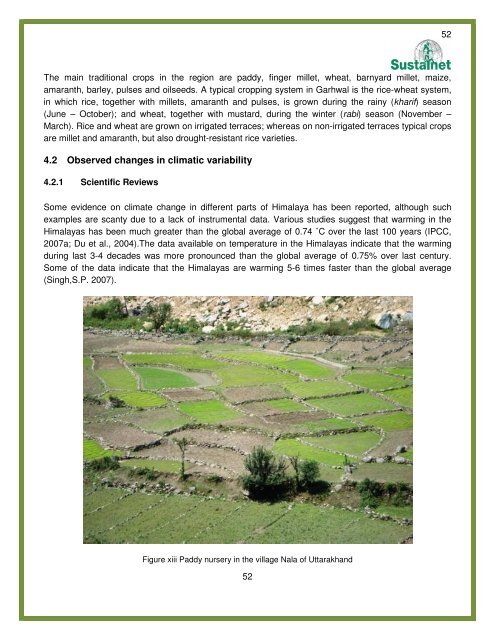Adaptation of small scale farmers to climatic risks in India - Sustainet
Adaptation of small scale farmers to climatic risks in India - Sustainet
Adaptation of small scale farmers to climatic risks in India - Sustainet
Create successful ePaper yourself
Turn your PDF publications into a flip-book with our unique Google optimized e-Paper software.
The ma<strong>in</strong> traditional crops <strong>in</strong> the region are paddy, f<strong>in</strong>ger millet, wheat, barnyard millet, maize,<br />
amaranth, barley, pulses and oilseeds. A typical cropp<strong>in</strong>g system <strong>in</strong> Garhwal is the rice-wheat system,<br />
<strong>in</strong> which rice, <strong>to</strong>gether with millets, amaranth and pulses, is grown dur<strong>in</strong>g the ra<strong>in</strong>y (kharif) season<br />
(June – Oc<strong>to</strong>ber); and wheat, <strong>to</strong>gether with mustard, dur<strong>in</strong>g the w<strong>in</strong>ter (rabi) season (November –<br />
March). Rice and wheat are grown on irrigated terraces; whereas on non-irrigated terraces typical crops<br />
are millet and amaranth, but also drought-resistant rice varieties.<br />
4.2 Observed changes <strong>in</strong> <strong>climatic</strong> variability<br />
4.2.1 Scientific Reviews<br />
Some evidence on climate change <strong>in</strong> different parts <strong>of</strong> Himalaya has been reported, although such<br />
examples are scanty due <strong>to</strong> a lack <strong>of</strong> <strong>in</strong>strumental data. Various studies suggest that warm<strong>in</strong>g <strong>in</strong> the<br />
Himalayas has been much greater than the global average <strong>of</strong> 0.74 ˚C over the last 100 years (IPCC,<br />
2007a; Du et al., 2004).The data available on temperature <strong>in</strong> the Himalayas <strong>in</strong>dicate that the warm<strong>in</strong>g<br />
dur<strong>in</strong>g last 3-4 decades was more pronounced than the global average <strong>of</strong> 0.75% over last century.<br />
Some <strong>of</strong> the data <strong>in</strong>dicate that the Himalayas are warm<strong>in</strong>g 5-6 times faster than the global average<br />
(S<strong>in</strong>gh,S.P. 2007).<br />
Figure xiii Paddy nursery <strong>in</strong> the village Nala <strong>of</strong> Uttarakhand<br />
52<br />
52




